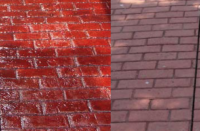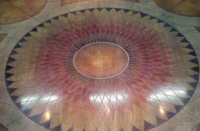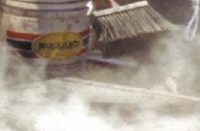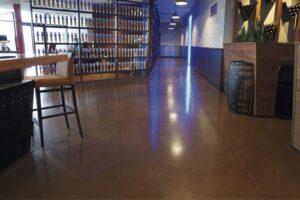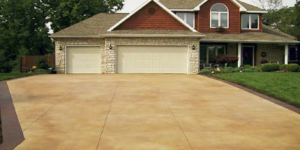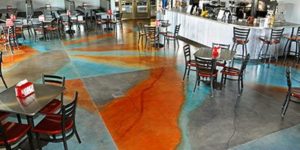Unlike acid stains, which achieve their natural good looks with a chemical reaction, today’s water-based copycats often rely on employing proper techniques.
Trevor Foster, regional sales manager and principal trainer for Miracote Products, touts one such procedure. “If you know what acid stains look like, our system is very easy to use,” he says.
Miracote’s water-based penetrating stain, Mirastain II, which has been around for a decade or more, can be used to emulate the look of acid staining without all the fuss. Available in 36 standard colors and endless custom colors, the eco-friendly product is made with polymer resin, water, isopropyl alcohol, a proprietary blend of flow and leveling agents, and liquid integral pigment.
“Its biggest advantage is that Mirastain doesn’t cause a chemical reaction,” Foster says about the stain. “You don’t need to wait for the stain to react with the free lime in the concrete and you don’t need to neutralize it. What you see is what you get. That’s a very big selling point.”
Throughout the year at distributors’ showrooms and warehouses across the country, Foster conducts threeday workshops in which he demonstrates how to use Mirastain to emulate acid stains. The handson training, geared for rookies and pros alike, covers everything from surface preparation to advanced application techniques.
“Spraying wet on wet is very critical with this system so the colors can flow together, mottle and variegate all as one,” Foster says. To produce highs and low, you overload some areas with pigments while lightly going over others. Two types of sprayers are involved — a pump sprayer and a high-volume, low-pressure spray gun — which are used simultaneously, streaming one color and churning another. “You just have to develop ‘the eye,’” he says. “It’s a very easy system to use if you know what you’re looking for.”
If you need more color in a certain area, “Boom, you know right then and there,” says Foster. And the colors in the line really make a difference. They can be diluted to get a light pink or used full strength to get a deep burgundy, vivid green or even a true black. “You’re not stuck with the same old colors,” he points out. Acid stains only offer about a dozen.
Miracote, with its alcohol content, has a much quicker drying time than acid-based stains, Foster continues. Rather than having to wait for the stain to react, then rinsing, then letting it dry and hydrate before sealing, you’re sealing in two to four hours. Overall, Foster estimates, his company’s technique could save 15 to 20 hours per man per job.
